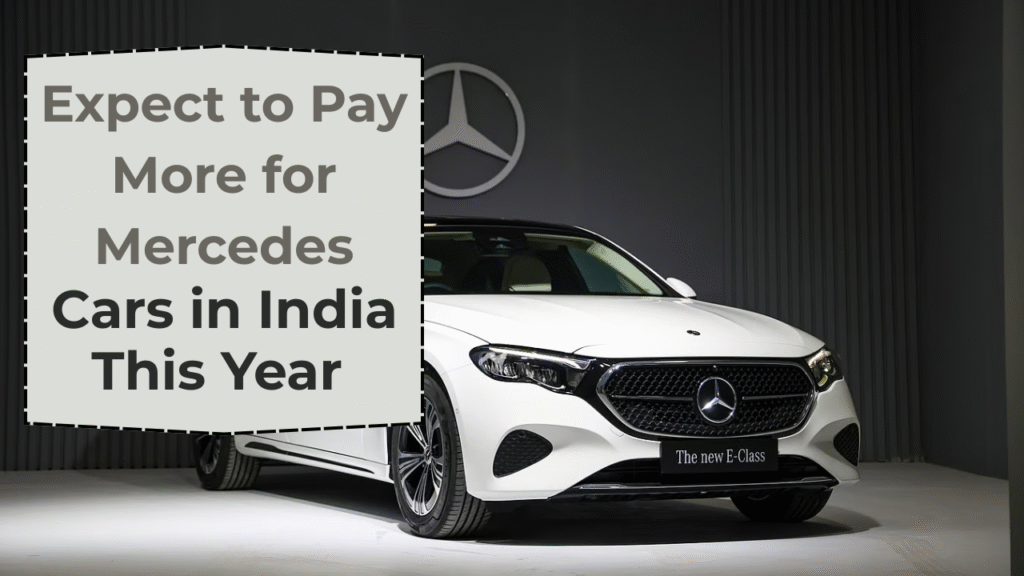Introduction
Luxury carmaker Mercedes-Benz India is set to increase the prices of its vehicles once again in 2025, citing a rise in input costs, logistics expenses, and foreign exchange fluctuations. The announcement comes as part of a larger trend among premium automakers seeking to maintain profitability in the face of global economic challenges. This marks the brand’s second price hike within a span of just a few months.
Why the Price Hike?
Mercedes-Benz India attributed the planned price hike to a variety of factors:
Increase in Input Costs
The cost of raw materials used in automobile manufacturing, such as steel, aluminum, and plastics, has surged in recent quarters. These materials play a crucial role in vehicle production, and the burden of higher material costs is inevitably being passed on to the consumer.
Forex Volatility
The depreciation of the Indian Rupee against major currencies, particularly the Euro, has further strained the company’s cost structure. Since Mercedes-Benz imports many components and models from Europe, fluctuations in foreign exchange rates have had a significant impact on the overall pricing.
Logistics and Supply Chain Challenges
The automotive sector has been grappling with supply chain issues globally. Transportation costs—especially for high-end vehicles that often require special handling—have gone up. This includes domestic freight costs as well as international shipping tariffs.
Details of the Price Increase
Mercedes-Benz India has announced that the price hike will be effective from July 1, 2025. On average, the prices of its models will increase by up to 2%. The exact increment will vary depending on the model and its specifications.
For instance:
- Entry-level models like the A-Class Limousine may see a relatively modest hike.
- High-end models such as the S-Class and the GLS could experience a larger increase due to their higher import content and premium positioning.
This will be the second price increase in 2025. Mercedes had previously raised prices in January by an average of 5%, citing similar economic pressures.
Market Impact
Consumer Sentiment
Industry analysts suggest that while luxury car buyers are typically less price-sensitive, multiple hikes in a year could prompt some consumers to either expedite their purchase before the price increase or consider rival brands offering better value.
Competitive Positioning
Mercedes-Benz continues to lead the Indian luxury car market, competing closely with BMW and Audi. Price hikes across the board may level the playing field in terms of pricing, but Mercedes will be counting on its brand value, dealer network, and customer service to maintain its edge.
Mercedes-Benz India’s Performance
Despite the rising costs, Mercedes-Benz India has shown strong performance in recent years. In 2024, the company reported a 12% year-on-year increase in sales, indicating robust demand for premium vehicles.
The company has also been expanding its product portfolio and local assembly operations. Models like the GLC and E-Class are assembled at its Chakan plant in Maharashtra, which helps mitigate some import-related cost burdens.
Industry-Wide Trend
Mercedes-Benz is not alone in announcing price revisions. Other automakers such as BMW, Audi, and Volvo have also either raised prices or signaled impending hikes. Rising operational costs and regulatory compliance requirements, such as those under the Bharat Stage VI (BS-VI) emission norms, are contributing factors.
In fact, according to data from the Ministry of Heavy Industries, the cost of compliance with BS-VI standards has added significantly to the manufacturing cost of vehicles.
What Should Buyers Do?
For potential buyers of luxury cars, especially those eyeing a Mercedes-Benz model, this might be the right time to finalize purchases before the July 1 deadline. Most dealerships are likely to witness a surge in bookings in the run-up to the hike.
Consumers are also advised to:
- Compare on-road prices across states
- Consider financing options before the increase
- Check for ongoing promotional offers or exchange benefits
Government Policies and Future Outlook
India’s automotive sector is under continual transformation with a focus on sustainability and electrification. Mercedes-Benz has already launched electric vehicles like the EQB and EQS in India. These models may also face future price revisions based on evolving battery import duties and electric vehicle incentives.
Conclusion
Mercedes-Benz India’s decision to increase prices reflects the broader cost pressures facing the automotive sector in 2025. With inflationary trends, currency depreciation, and global supply chain issues continuing to challenge manufacturers, price hikes have become a necessary move for sustaining operations and profitability.
Consumers planning to invest in a luxury vehicle may want to act swiftly to avoid the upcoming price increase, while the industry continues to adapt to evolving market and regulatory dynamics.




